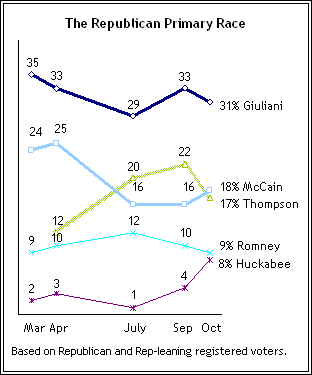
Rudy Giuliani continues to hold a substantial lead in the GOP primary race. Among Republican and Republican-leaning registered voters, 31% currently favor Giuliani, with John McCain (18%) and Fred Thompson (17%) in a virtual tie for second place. Thompson’s support has dropped five points from a month ago, mostly as a result of decreasing enthusiasm among conservatives in the party.
Former Arkansas Gov. Mike Huckabee is the main beneficiary of Thompson’s losses. Huckabee’s support has risen from just 1% in July to 4% in September and 8% in October. Huckabee currently runs about even with Mitt Romney (9%) among Republican and Republican-leaning registered voters nationwide.
There has been less movement in the Democratic race in recent months. Hillary Clinton continues to build on her already substantial lead among Democratic and Democratic-leaning registered voters. She leads Barack Obama by nearly two-to-one (45% to 24%) in the latest survey, with John Edwards a distant third at 12%.
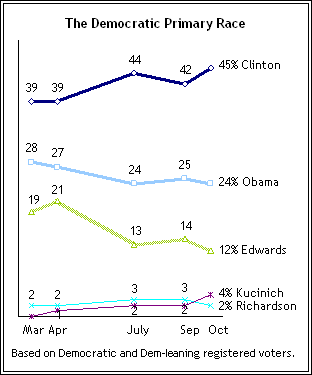
Clinton’s growing advantage over the past six months has come largely among Democratic groups who were Barack Obama’s strongest supporters earlier in the year — liberals, college graduates and young people. While Obama continues to run well among these voters, Clinton has opened a sizable lead in all three groups since March and April of this year.
The Democratic Primary
Hillary Clinton is the favored candidate for the Democratic nomination across nearly all segments of the party base. Clinton holds a 21-point lead over Obama (45% to 24%) among registered Democrats and Democratic-leaning independents, a margin virtually unchanged from September. When data from these two months (September and October) are combined to analyze subgroups within the party base, Clinton’s lead is remarkably solid. She holds a double-digit lead among liberal, moderate and conservative Democrats, as well as among Democratic voters of all ages.
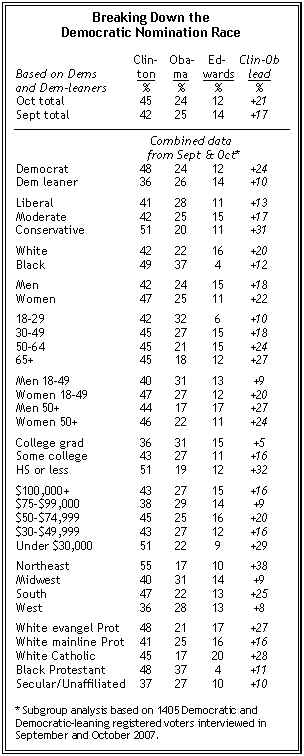
In Pew surveys conducted in March and April, Barack Obama ran even with Hillary Clinton among liberal Democrats (35% to 35%). Today, Clinton has opened a 13-point lead (41% to 28%). But Obama continues to run considerably better among liberal Democrats than he does among conservatives. Clinton holds a 31-point lead among conservative Democrats (51% to 20%), which is virtually unchanged from earlier in the year.
Similarly, in March and April Democrats under age 30 favored Obama over Clinton by a 42% to 34% margin. While younger Democratic voters continue to express more support for Obama than do older Democrats, Clinton has now reversed these figures among 18-29 year olds. She now leads Obama by 42% to 32% among younger voters, and has expanded her lead among Democrats over age 30 as well.
Barack Obama continues to run competitively with Clinton among college graduates, though also he has lost some ground here. In the latest polls, he trails Clinton by only five points (36% to 31%) among college-educated Democratic voters, a very close margin when compared with the overwhelming 51% to 19% lead Clinton holds among Democrats who never attended college. But in March and April, Obama led Clinton among college graduates by a seven-point margin (36% to 29%).
While gender may prove to be a major factor in the general election if Clinton becomes the Democratic nominee, it has played little role in the primary so far. Men and women express virtually identical preferences in the Democratic primary, with women only somewhat more likely to name Clinton as their preferred candidate.
Clinton’s strongest region of the country remains the Northeast, where she leads Obama by 38 points (55%-17%). She also holds a greater than two-to-one advantage among Democratic voters in the South, (47%-22%); however, Clinton leads Obama by only nine points in the Midwest and by eight points in the West.
African American views of the Democratic field are virtually unchanged from earlier in the year. In the most recent surveys, 49% of blacks support Clinton, and 37% Obama, with no other candidate garnering a significant level of support (Edwards is third at 4%). In the March and April surveys, African American Democrats favored Clinton by an almost identical 48% to 37% margin.
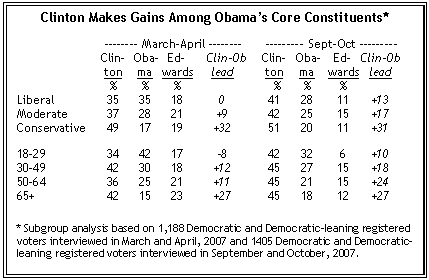

Though Clinton has not advocated an immediate withdrawal from Iraq as part of her campaign platform, she runs at least as well among Democrats who want an Iraq pullout as among those who do not. In fact, 50% of Democrats calling for an immediate troop withdrawal back Clinton, compared with 44% of those who want a more gradual withdrawal and 40% of those who say the U.S. should stay in Iraq until the situation is stable. While John Edwards has made an effort to position himself as a stronger opponent of the war than Clinton, he gets less support from Democrats who want an immediate pullout than from those with more moderate views. Not surprisingly, Dennis Kucinich garners his highest figures among Democrats who favor immediate troop withdrawal. Even so, just 6% of these Democrats favor him for the nomination.
The Republican Race
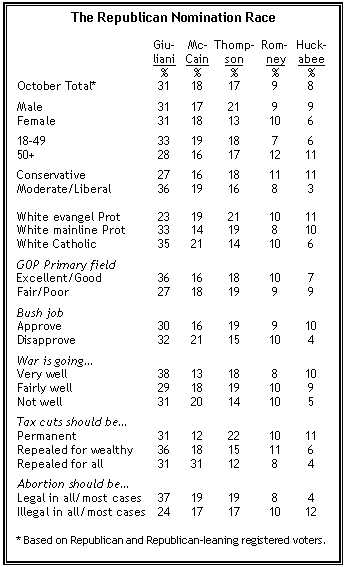
While Giuliani leads among nearly all major segments of the GOP base, his standing among conservative Republicans remains the most tenuous. Where Giuliani holds a 17-point lead over his closest competitor among moderate and liberal Republicans (36% to 19% for McCain), he holds just a nine-point edge (27% to 18% for Thompson) among conservatives. And the matchup is even tighter among white evangelical Protestants, 23% of whom back Giuliani, 21% Thompson, and 19% McCain.
But no clear alternative has arisen to take advantage of the lack of enthusiasm for Giuliani among conservatives. A month ago, Fred Thompson appeared to be this candidate — garnering the support of 22% of Republicans overall and 25% of conservatives, but he has dropped five points overall and seven points among conservatives in the past month. Mike Huckabee’s rise in the polls is due almost entirely to his growing support among conservatives in the party. While he remains far out of the lead, his backing among conservatives has increased from 7% to 11% since September, and he now enjoys as much conservative support as Romney (11%). Yet Huckabee’s appeal to moderate and liberal Republicans stands at just 3% nationwide.
The issue of abortion may be a factor in Giuliani’s candidacy, but again no candidate has consolidated the support of pro-life Republicans. Perhaps more important, there is hardly a consensus about abortion within the party. While a 51% majority of Republican and Republican-leaning voters believe abortion should be illegal in all or most cases, 43% say it should be legal in all or most cases.
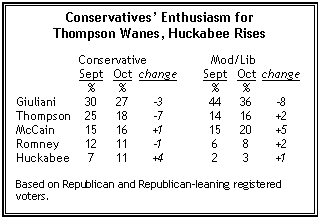
Among the former, Giuliani receives the support of just 24%, compared with 37% among the latter.
Conservative Revolt?
Conservative Republicans are not notably enthusiastic about the slate of Republican presidential candidates, but they have more positive impressions of the field than do GOP moderates and liberals. Among Republican and Republican-leaning voters, a solid majority of conservatives (55%) rate the Republican candidates as excellent or good. That compares with a 44% positive rating among the smaller number of GOP moderates and liberals.
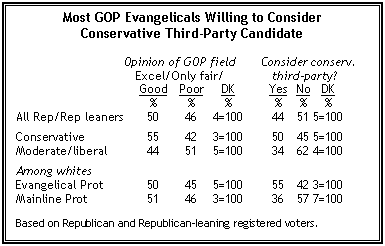
However, when presented with a scenario in which the general election candidates are Giuliani and Clinton, along with “a third party candidate who holds more conservative positions on social issues like abortion and gay rights,” half of conservative Republicans say they would consider voting for such a candidate. Just 34% of GOP moderates and liberals say they would consider voting for a third-party candidate who takes conservative positions on social issues.
White Republican evangelical Protestants express the greatest willingness to consider voting for a conservative third-party candidate. More than half of white Republican evangelicals (55%) say they would consider this, compared with 36% of white Republican mainline Protestants and the same proportion of white Republican Catholics.